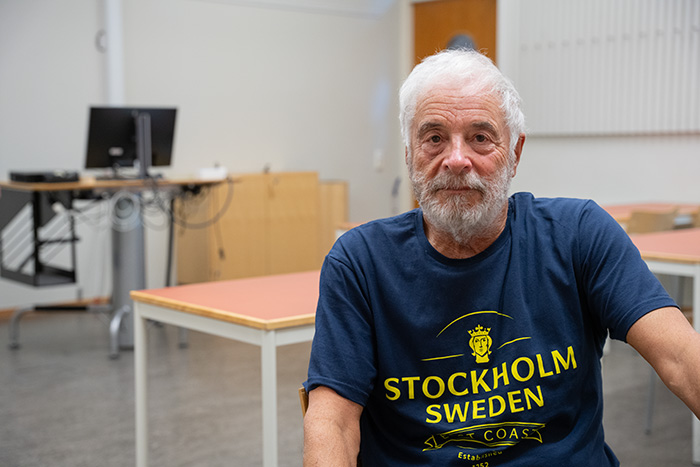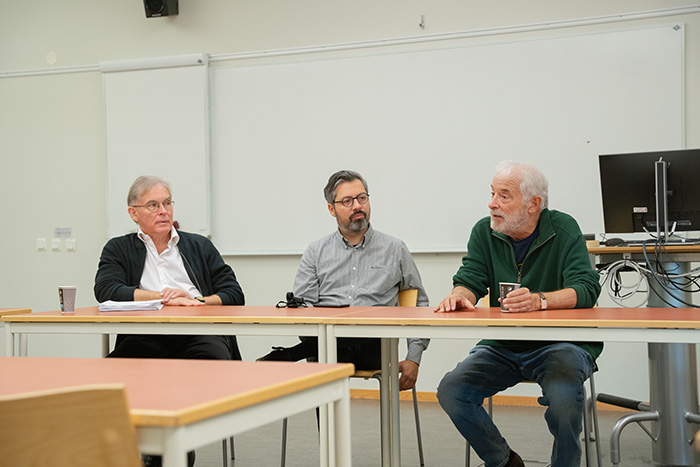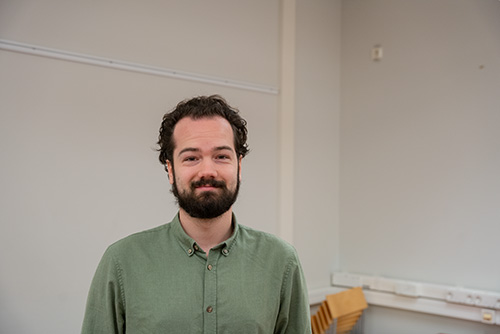Child of Holocaust survivors tells his story
Abraham Dortheimer, the son of two Holocaust survivors, hosted the School of Education and Communication (HLK) at Jönköping University (JU) On Tuesday 1 October. Abraham was born in Jönköping and has come back to Sweden from the US to find the missing pieces of the puzzle about his parents.

Abraham Dortheimer
The fact that Abraham Dortheimer came to HLK to tell his story is thanks to Radu Dinu. Radu is a Senior Lecturer in history at HLK and thought it would be appropriate for his history students to hear Abraham's story.
Abraham has visited Sweden and Denmark together with Therkel Straede, Associate Professor in modern German history at the University of Southern Denmark. Together they are trying to map and time Abraham's parents' lives up until they emigrated from Sweden to the United States in May 1953.
“I'm writing an autobiography, and the years after my parents were in the concentration camps up until we finally arrived in New York are the last missing pieces of the puzzle. The book won't be sold, I'm writing it for myself, but those who are here today will get a copy,” he says.
Mother Chana
Abraham's mother, Chana Kozlowska (later Dortheimer) was born in 1922 and came from Lodz, Poland. After the Germans invaded Poland in 1939, her mother, father, younger brother and many other relatives were killed. Chana and her sister were deported to Auschwitz where they spent a few months before being transferred to Ravensbrück or one of its satellite camps that were in need of labour. As the war drew to a close in 1945, the sisters were rescued by the Swedish Red Cross and the “white buses”. They ended up in Malmö, but there the trail disappeared.
Father Henryk
Abraham's father, Henryk Dortheimer was born in Krakow, Poland. When he was 14 years old, Henryk´s four brothers and one sister were killed by the Nazis. Henryk, his brother-in-law Jozef and his girlfriend Chawa were spared. Henryk and Jozef were both sent to several different concentration camps. The three of them managed to survive and even immigrate (probably illegally) to Sweden. Jozef and Chawa later got married in Jönköping.
"My parents weren't too keen on talking about this time, which I can understand. I wasn't very curious before either, and now there's no one left to ask, so now I have to do my own research," says Abraham.

Therkel Straede, Radu Dinu and Abraham Dortheimer.
Jönköping
Henryk and Chana were married in 1948, when they lived in Jönköping. The years up to that point, and how or where they met, are still a mystery. In an official form that was discovered, Chana had written that she worked as an industrial worker, but where, or if it is true, Abraham and Therkel do not know. It is possible that Chana used her maiden name, and this is currently being investigated.
Abraham and Therkel recently learnt that the couple lived on Slottsgatan in Jönköping and that in 1950, when Abraham was one year old, he was taken away from his parents and placed in Vårsol, a care home run by the Salvation Army (the home still exists). They believe he was taken into care because Slottsgatan was very run-down at the time and perhaps the authorities thought it was harmful for young children to live there. Henryk and Chana got Abraham back after nine months, by which time they had moved to another apartment on Slottsgatan.
It is known for certain that Henryk worked at Husqvarna as a spray painter. There is an employer's certificate from Husqvarna that the Dortheimers used when they applied under a quota system (in the US it was called the Displaced Persons Act) at the American consulate. They also believe that Henryk may have worked at the brush factory in Bankeryd just outside Jönköping. The investigations into this period of their lives is ongoing.
Emigrated to United States
In May 1953, the Dortheimer family emigrated to the United States. It is known that they first sought asylum in Palestine, but without success. They ended up in the USA in New York, where Henryk got a job as a painter and where Abraham grew up and lived his life.
“The book will be a little about my parents, their background, Poland and the war, but the biggest part is still about Sweden. This is where everything somehow both begins and ends. When I go back to the United States, I will finish the book using everything we have found here in Sweden. I hope I will come back to Sweden. Maybe my children or grandchildren also will be interested, you never know what the future holds,” says Abraham Dortheimer.

Jakob Svensson
“Will definitely use this in my teaching role”
Abraham and Therkel’s lecture was optional for the students, but for Jakob Svensson, a student teacher with History as a second subject, it was an obvious choice.
“This is so important for Swedish schools. Unfortunately, there are not many survivors left, so hearing it from second generation survivors is very valuable. When I am a teacher, I will definitely use this meeting with Abraham as an example,” he says.
